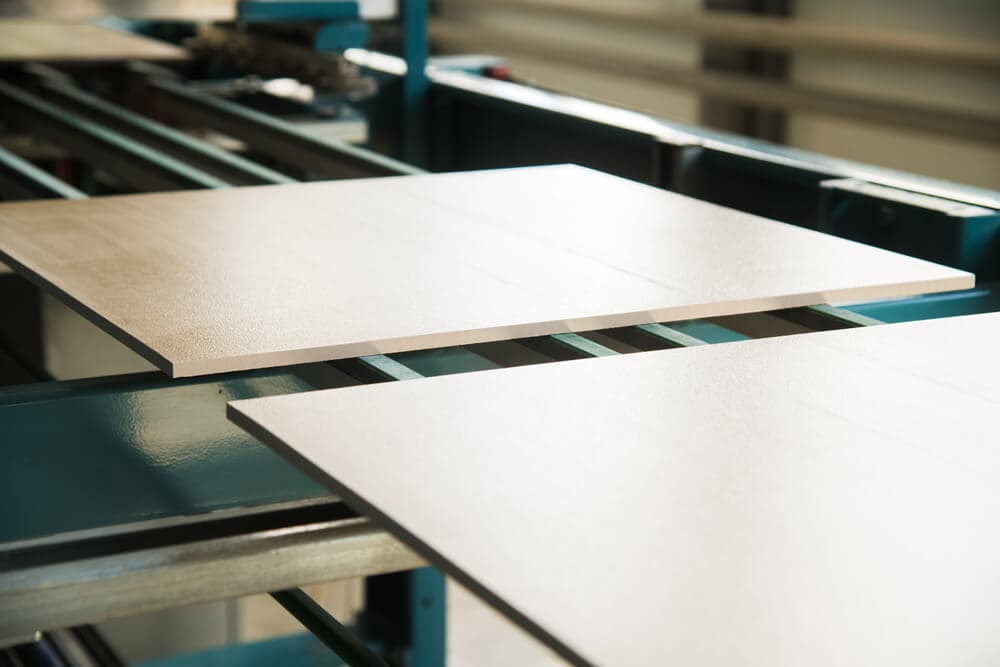The Components of Ceramic Tile
Ceramic tile is composed of a range of naturally-occurring minerals found in abundance all over the world. Each ingredient of ceramic tile has a unique technical property and undergoes robust testing by a raw material supplier to ensure a high level of quality for the long-lasting performance of the fired, finished product.
Ceramic tile is most commonly composed of Ball Clay, Feldspar, Kaolin, and Bentonite. Experts at Imerys, a global provider of mineral-based products, have helped us define these ingredients:
Ball Clay

Ball clay, which can be easily formed and compacted into a variety of shapes, is an essential mineral in tile production for its formability and binding properties.
A tile that has been formed but not yet fired is referred to as “green body.” Ball clay’s adhesion qualities throughout the green body allow the body to hold its shape throughout the decoration process prior to firing. This high “green strength” ultimately means less waste of materials and energy.
Feldspar

The addition of a fluxing agent to clay is important to help materials melt well together during the firing of the tile. The mineral Feldspar is used as the main fluxing agent in ceramic bodies. It gradually melts over a range of temperatures, which facilitates the bonding and vitrification of other raw materials at lower-than-normal production temperatures. Feldspar usage allows producers to lower the firing temperature or shorten the firing cycle, resulting in energy and CO2 savings. In addition to the process benefits, Feldspar enhances the mechanical strength of the fired tiles and creates a lighter body color for more aesthetic design possibilities.
Kaolin

Kaolin is another type of clay, traditionally added in small amounts to tile body formulas to enhance specific properties such as mechanical strength. Because kaolin has a different particle size than other clay elements, the addition of kaolin can increase the variety of particle sizes within the body mixture, which is advantageous toward achieving optimal shaping, drying, and firing. When compacted, Kaolin also offers high dry strength, meaning that as an additive, it helps reinforce and strengthen the final product.
Additionally, kaolin is used to provide a whiter firing color. Kaolin’s high whiteness is desirable for certain specialty applications where color accuracy and/or bright white aesthetics are critical, such as with fine china and porcelain. The ceramics industry uses only a small amount of the total kaolin mined worldwide. Kaolin is also used in the manufacturing of many other products, from paper to cosmetics, paint, and agricultural products.
Bentonite

Bentonite is a mineral used in small quantities for specialty applications and is known for very high green strength to create strong, unfired tiles. Strength at the greenware stage is critical for making very large tiles, which must not bend or warp under their own weight. The market for XXL tiles is quickly growing in popularity for applications such as large wall coverings, showers, and kitchen countertops.
Ceramic Tile Benefits for a Healthy Planet
It is important to note that the minerals used to make ceramic tile are often sourced within 500 miles of manufacturing facilities, significantly reducing the emissions and energy associated with long-distance shipping.
To create ceramic tile, these minerals are mixed together, formed into a desired shape, and fired in a kiln. The process of firing these ingredients — to temperatures generally more than 2000°F — burns off all organic compounds resulting in an inert, allergen-free, and durable hard surface.
Ceramic tile’s durability allows it to be used for generations, and because ceramic tile is made from naturally-occurring materials, it typically qualifies for use as clean fill at the end of its long life cycle.
To learn more about the health and sustainability benefits of ceramic tile, visit Why Tile’s Sustainability Guide.




